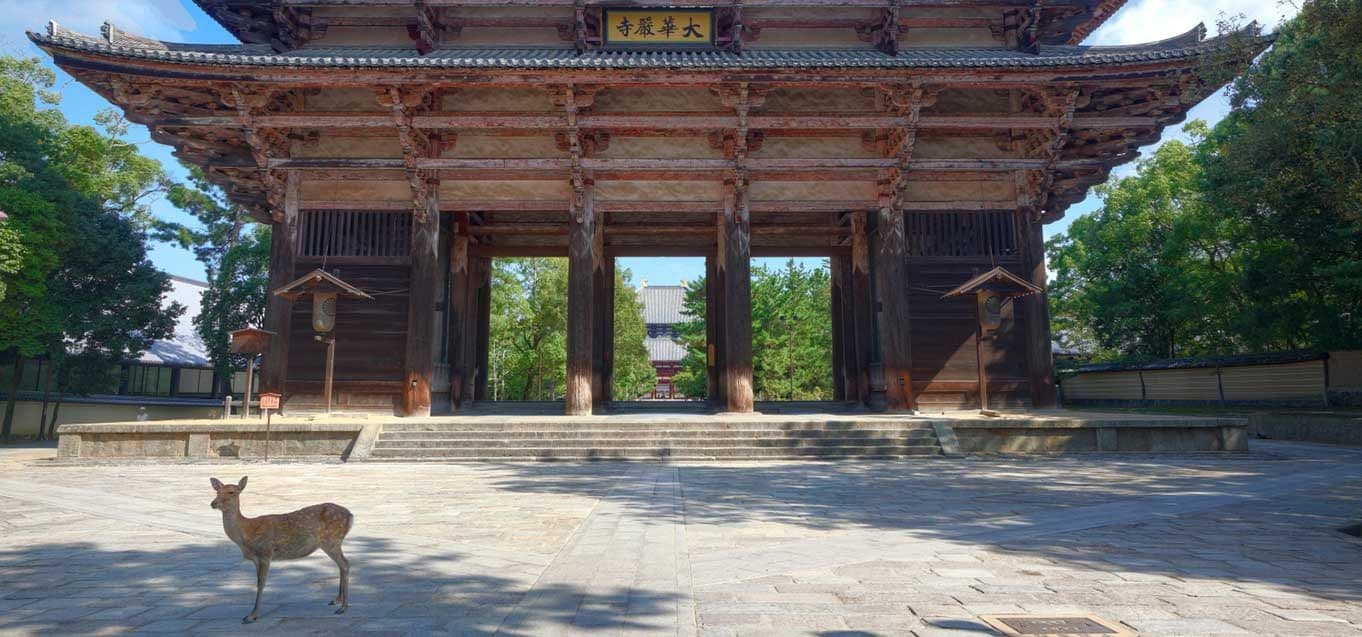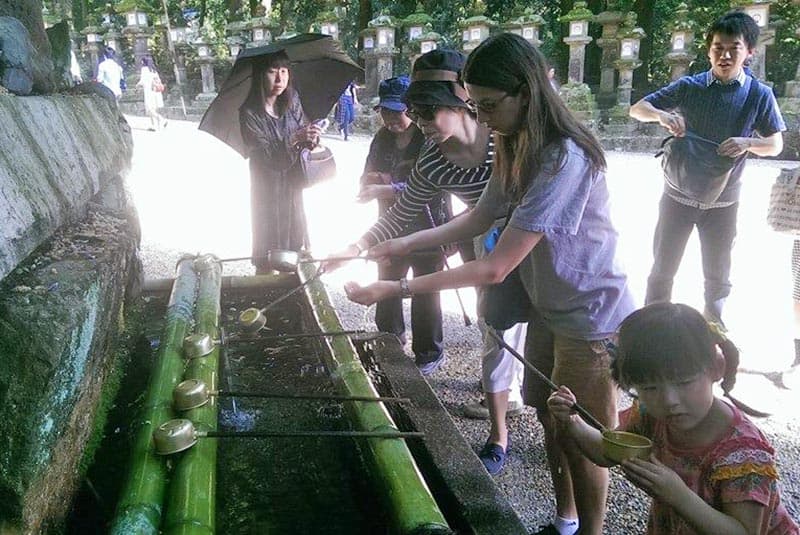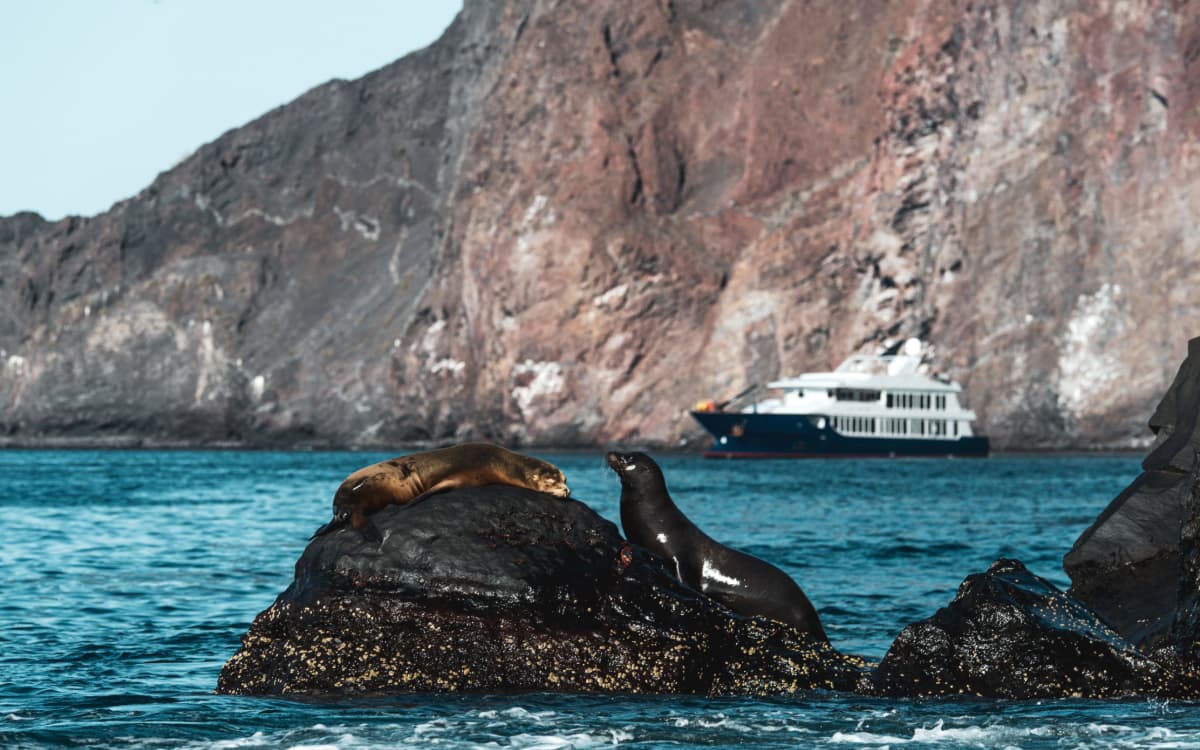Wanderlust

Aug 15, 2025
The Sacred Bowing Deer of Nara, Japan
Written by
Julia Franco

Before I visited Nara, Japan, I thought I knew all about deer. As the daughter of a park ranger, I had plenty of experience interacting with them. When my dad did late-night population surveys on Angel Island, in San Francisco Bay, after the tourists had all gone home, I rode in the van with him and yelled, “I see one!” every time I spotted deer eyes reflecting their telltale green. In shedding season, my family collected antlers that the local mule deer had dropped. I knew terms like “stotting” (a distinctive stiff-legged bounding motion), “rut” (the mating season, when male deer are especially aggressive), and “velvet” (the thin layer of fuzzy skin that covers antlers while they’re re-growing).
I was no idealist when it came to deer, despite my childhood obsession with Bambi. I knew that every year, deer killed more people in state parks than any other wild animal. Most of those deaths occurred from vehicle collisions, but gorings did happen. Antlers are not just for show.
One of my most vivid memories from Angel Island is of being chased by a buck while walking home one day. I was seven, old enough to make the trek from the docks past my dad’s office and home by myself, but young enough to not have a great grasp of risk analysis. I spotted the buck and recalled that it was rutting season, which meant all the male deer were headbutting each other in fights over does (female deer). What would happen, I wondered, if I walked up to the deer and pretended I was going to headbutt him? I veered off the road towards the deer, lowering my head as I had seen bucks do. The buck stared at me, possibly doing some risk analysis of his own. Then he charged. And I ran.
I was lucky that day. I had staged my provocation close by my dad’s office and, as he tells the story, he looked out the window just in time to see what was happening, grab his gun, and run outside. The deer must not have been very motivated, because by the time my dad got to me, the deer had already stopped and retreated into the surrounding forest. I was a bit shaken but also exhilarated at my brush with danger. My dad was less enthused. I received a stern lecture later that day, which I dutifully internalized.
The rules my dad taught me were absolute: Don’t feed wild animals. Don’t touch wild animals. Habituating them to people puts the animals and the people at risk. Treat wild animals like wild animals, not like cute pets.
* * *
Fast forward to college. I was 20 years old, on an exchange program in Kyoto, and some of my fellow exchange students had invited me on a trip with them to Nara.
Nara contains the Nara National Museum, Todai-ji Temple, and innumerable ancient Shinto shrines, but that wasn’t why I wanted to go. I was interested in the deer.
Nara Park is 1,240 acres, which provides room for approximately 1,200 deer, or about twice as many deer as full-time human inhabitants. Tourist guides will tell you that they’re called sika or shika deer, which is actually redundant because shika is just the Japanese word for “deer.” Historically, they were considered divine messengers. The legend goes that the thunder god, Takemikazuchi, appeared in Nara riding on a white deer. The deer carried a scroll in its mouth, and Takemikazuchi warned the awestruck mortals who beheld him that from that point on, the deer would report their actions to the gods. The humans took note, built shrines, and granted the deer protection. Killing one of these sacred Nara deer was punishable by death, and so for hundreds of years, the animals roamed freely. They became semi-tame around humans, losing the fearfulness that most deer species possess.

After World War II, when many Japanese were eager to cast off the past, the deer’s sacred status was officially revoked. Today, they are a popular tourist draw. Vendors in the park sell shika senbei, “deer cookies,” to feed to them.
All of this was intriguing, but my park kid instincts rebelled. Feeding wild animals? Getting close enough to touch them? That was how half my dad’s cautionary tales began.
On the other hand, I was studying abroad! It was time to take a few risks and do things I would never dream of doing back home. So, one weekend, my friends and I hopped on Japan’s incredibly efficient train and less than an hour later, arrived in Nara.
* * *
Feeding in the Wild
I saw the first group of deer just outside the park’s entrance. They lay on the ground with their legs neatly tucked under them, chewing their cud and seemingly oblivious to the tourists stopping to take photos.
Most photos of Nara’s deer show them in their summer coats: soft, orange-toned brown decorated with perfect white spots. But I was there in May, when the deer were just starting to shed their winter coats. Their fur was a dull murky brown, and tufts had fallen out unevenly, as though they’d had a haircut from an incompetent barber. I could see why they had been downgraded from “messengers of the gods” to “tourist attraction.”
We continued into the park, stopping at a vendor’s stall to buy shika senbei for 150 yen, or about $1.50, per packet. One of the other students, Arianna, bought a map of the park and tucked it into her pocket.
Finally, it was time to feed the deer, and the deer knew it. As we stepped off the path towards a small herd, they began to gather. They circled us, coming almost, but not quite, close enough to touch. I was shocked at how small they were. I stand five feet tall exactly, and the deer barely reached my waist. Had a group of American mule deer circled me, I would have been rightfully worried, but this felt like being surrounded by a group of unusually polite hooved dogs.

I offered a shika senbei, and a doe approached to inspect it. She stretched out her neck and extended a pale pink tongue. Her nimble lips took the treat from my hand without touching my palm, and she withdrew to eat her prize. More deer jostled for position, their nostrils flaring at the smell of food. I couldn’t stop smiling as I fed them, one after another. It would be suicide to do this with, say, a moose, but these little deer were adorable. Surely feeding them was harmless.
As another deer approached, I reached out to touch her. I had just barely grazed her fur when she drew back. Deer eyes are set on the sides of their head, which means if one wants to look directly at you, the deer must turn its head and stare with only one eye. That was what this deer did, and I realized that she was, quite literally, side-eyeing me. A rule had been laid down: Look, but do not touch.
I knew enough to heed the warning. Shika deer are nicknamed “bowing deer” in Japan for the way they sometimes lower their heads at visitors. The motion resembles a courteous bow, but it is actually an implied threat of headbutting. This cross-species cultural misunderstanding has its costs. In 2016, a year after I visited Nara, Japan, 121 people were injured by the deer, mostly while feeding them. But unlike in American parks, no one was killed, and all of the injuries were minor. A miracle? Luck? The logical outcome of shika deer being so small? Only the gods knew for sure.
With our supply of shika senbei nearly exhausted, my friends and I continued on through the park. We took photos of shrines, of the surrounding trees, and of course, of more deer. Most of the deer we saw were does, so when a buck approached, I noticed him right away. He stood a little taller than the females, and his short antlers were covered in velvet.
Arianna fed him the last of the shika senbei. The buck took them from her hand, then looked up expectantly for more.
“Sorry, that’s it,” Arianna said. The buck considered this. Then, very deliberately, he leaned forward and took the map from her pocket.
“Hey!”
The buck was already chewing. Without thinking, I reached for the map. I knew how to open an animal’s mouth. Get a hand on each side of the lower jaw, hook your thumbs into the corners of the mouth, and press on the mandibular joint. I had done it with pets trying to eat something they shouldn’t a hundred times. The motion was practically automatic.
As my fingers grazed the buck’s jaw, I remembered: This isn’t a pet. It’s a wild animal. The buck tossed his head and stepped back, still chewing. He did not seem perturbed at nearly being manhandled. This was an animal used to a certain amount of respectful distance, and though I had breached that distance, he was still willing to tolerate us.
“It’s okay, I’ll buy another map,” Arianna said.
We walked on, leaving the buck to his own devices.
I felt embarrassed at having nearly wrenched open the jaws of an animal once called sacred. All of my dad’s advice, all my lectures to friends about respecting the boundaries of wild animals—all of it had been forgotten in an instant. I had let myself be lulled into a false sense of complacency by the apparent tameness of the deer. They weren’t wild American deer, but they weren’t harmless pets either. I was still trying to understand what, exactly, they really were.
* * *
A Ritual Worth Keeping
The shrines and temples of Nara are still sacred, even if the deer are not, and when in a sacred space in Japan, there is a ritual washing one is expected to do. Every major shrine has at least one trough of water for this purpose. Little ladles rest on the edges of the troughs for scooping water out. Water is poured first over your left hand, then your right, then a little into your cupped left hand, which is then used to rinse your mouth.
We passed one of these troughs now. A deer statue stood over it, a buck not unlike the one who had just eaten the map, but larger than life. Like the deer of legend, he held a scroll in his mouth, and water poured from one end of the scroll into the basin, making a gentle rushing sound. His stony eyes watched as my friends and I washed our hands, chatting about what we had seen so far.

Dust rose around us as other visitors walked by. We finished washing, returned the ladles to the basin, and walked on. The warm sun shone down, and trees draped shadows over our path.
There are valid criticisms of deer-feeding, but it’s worth pointing out that tourism to Nara has kept these deer alive. Shika deer once roamed as far as Russia and Vietnam. Their populations have shrunk everywhere except Japan. In Nara, tourism is a major source of funding for the park and everything in it. The deer’s return to sacred status may not be so far off: Without the bowing deer, it would be difficult to pay for the upkeep of the many shrines.
I had come to Nara with very strict ideas of how people are supposed to interact with wild animals, but animals have a way of surprising you. They take your road map and tear it up—sometimes literally. They will not be contained to neat binaries: sacred or mundane, wild or tame, gentle or dangerous, but always some combination of all of the above.

I’d like to imagine that buck galloping up into the heavens, holding not a scroll but a half-chewed map in his mouth. I’d like to imagine Takemikazuchi chuckling in a thunderous rumble, and sending the deer back down, back to the peace and beauty of Nara.
#####
To explore options for Japan travel, browse GeoEx’s custom and group trips to Japan or call our adventure travel specialists at 888-570-7108.






